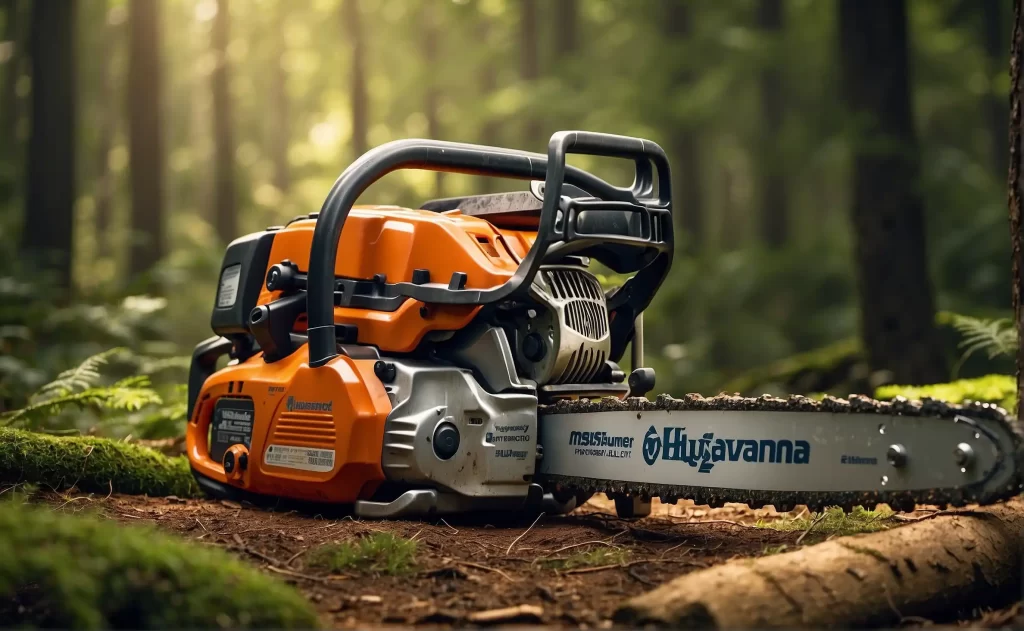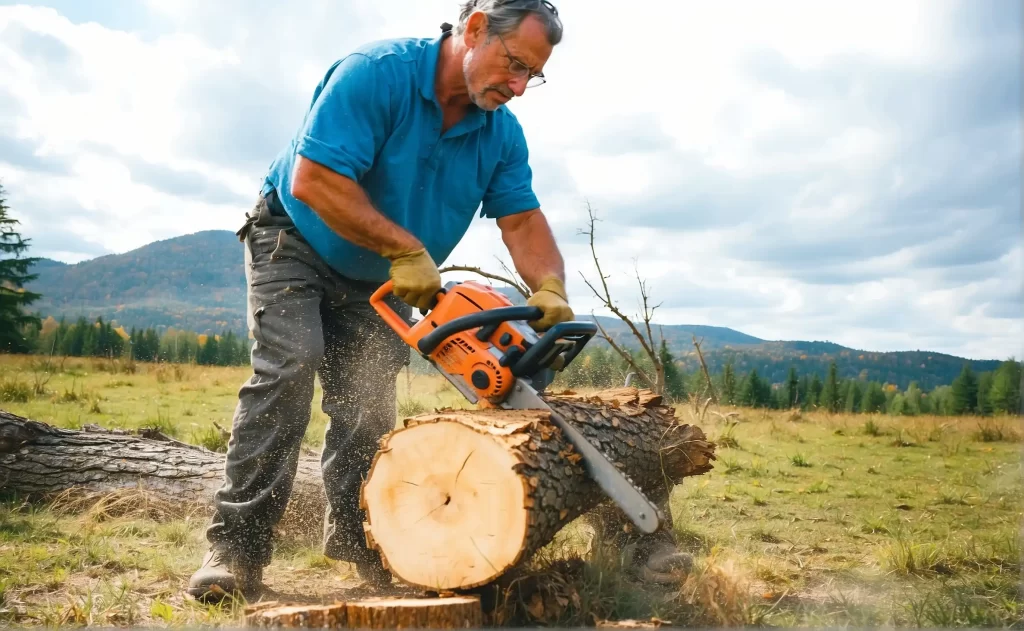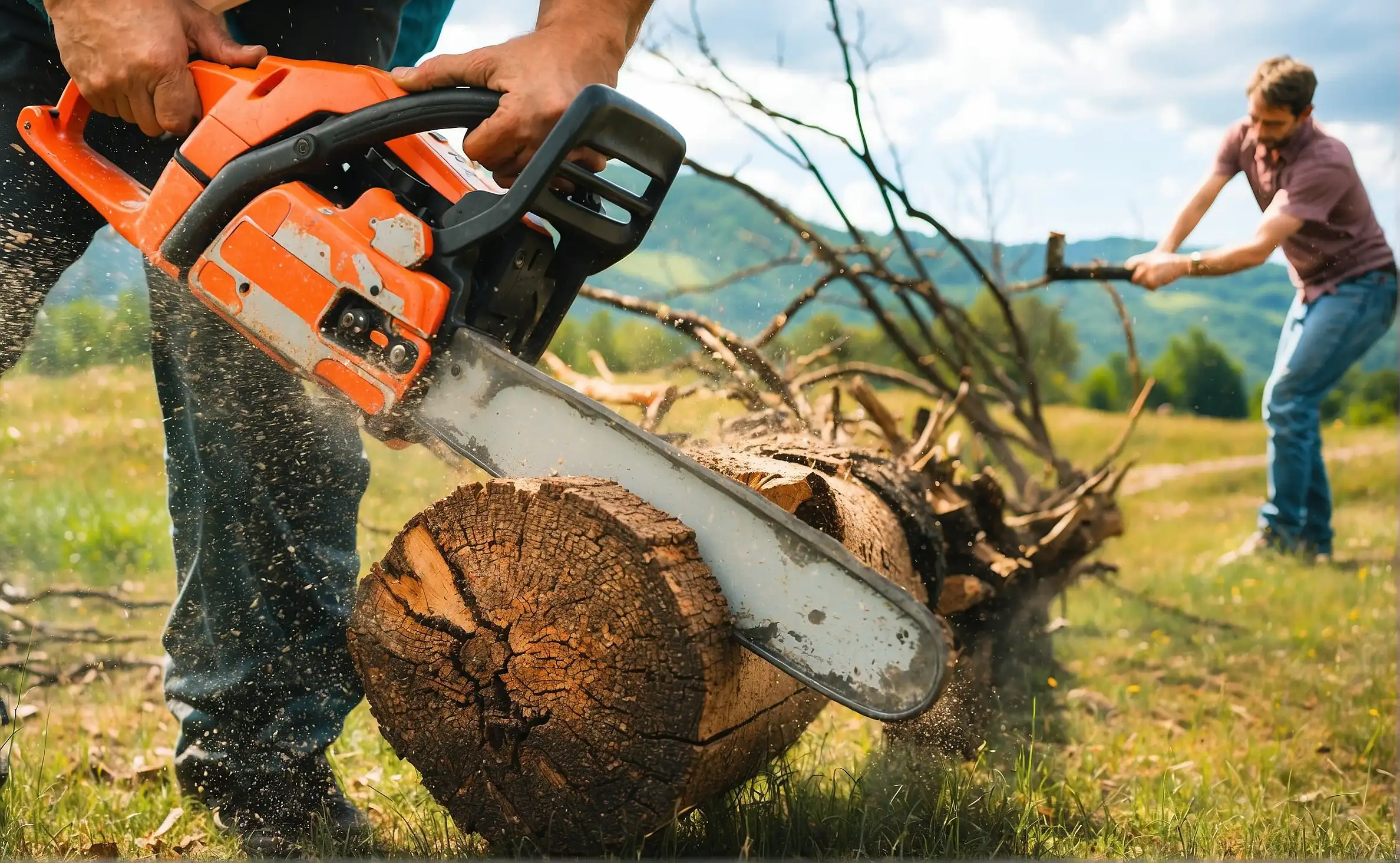The Husqvarna 460 Rancher is an excellent chainsaw for cutting firewood, combining power and versatility. The Stihl MS 251 Wood Boss also ranks highly with its efficiency and ergonomic design.
Selecting the best chainsaw for cutting firewood is crucial for efficiency, safety, and ease of use. The Husqvarna 460 Rancher excels due to its robust 60. 3cc engine that delivers ample power for various wood types. This chainsaw ensures a reliable start and smooth operation, making it a top choice for homeowners and professionals alike.
Its 20-inch bar allows for effective cutting of large logs, while the anti-vibration system reduces user fatigue. The Stihl MS 251 Wood Boss, on the other hand, is renowned for its fuel efficiency and comfortable handling, ensuring it remains a preferred option for those who prioritize a mix of performance and ergonomics. Both chainsaws stand out in the market for their durable construction and ease of maintenance – factors paramount for regular users of firewood cutting equipment.
The Perfect Firewood Chainsaw
When the leaves start to turn, and the air grows crisp, many of us feel that primal call to prepare for the coming winter. Gathering firewood becomes a seasonal tradition, as well as a necessity. For avid woodcutters and homeowners alike, finding the best chainsaw for cutting firewood remains a top priority. The right chainsaw can turn what could be a daunting task into a rewarding and efficient process. A perfect chainsaw slices through wood with power, precision, and durability, making each cut as satisfying as the cozy fires those logs will eventually fuel.
Understanding the Needs Of Firewood Cutting
Cutting firewood is no small feat; it demands a tool that’s up to the challenge. Firewood cutting involves more than just sawing through timber—it’s about consistency, efficiency, and safety. The ideal chainsaw for this job needs a blend of power to handle various wood types, ease of use to ensure anyone can operate it safely, and reliability for prolonged cutting sessions.
- Power: to tackle hardwoods and softwoods alike
- Ease of Use: user-friendly features for safe operation
- Reliability: starts reliably and continues running through long work sessions
Criteria For Choosing A Chainsaw
The criteria for selecting the right chainsaw for cutting firewood is critical. With the myriad options available in the market, assessing the following aspects will help navigate to the ultimate choice.
| Criteria | Description |
|---|---|
| Engine Type | Gas, electric, or battery-powered, each offers varying balances of power and convenience. |
| Bar Length | Depends on the size of wood you plan to cut; longer bars can handle larger diameter logs. |
| Weight | A lighter chainsaw reduces fatigue but might offer less power. |
| Chain Type | Chains designed specifically for cutting firewood can enhance efficiency and lifespan. |
| Maintenance | Easy access to parts and straightforward care keep your chainsaw in top condition. |
| Safety Features | Important to minimize the risk of accidents, features like anti-kickback protection are essential. |
Balancing these factors will ensure the chainsaw you choose will not only satisfy your immediate needs but will also stand as a reliable partner for many woodcutting seasons to come.
Types Of Chainsaws For Firewood Cutting
Embarking on the seasonal task of cutting firewood necessitates the right tool for efficient and safe work. Various types of chainsaws cater to different preferences and needs when it comes to slicing through timber. Exploring the distinctions among gas, electric, and battery-powered chainsaws allows you to make an informed decision tailored to your firewood processing endeavors.
Choosing the ideal chainsaw for cutting firewood depends on factors such as the environment you are working in, the quantity of wood to be cut, and the physical effort you are willing to exert. Let’s delve into the different types available.

Comparing Gas, Electric, and Battery-powered Chainsaws
The three predominant types of chainsaws available on the market today can be compared based on power source, each bringing its unique strengths to the table.
| Chainsaw Type | Power Source | Usability | Power Output | Maintenance |
|---|---|---|---|---|
| Gas-Powered | Combustion Engine | Highly Mobile | Most Powerful | Regular Maintenance |
| Electric (Corded) | Electricity (Cord) | Limited by Cord | Moderate Power | Minimal Maintenance |
| Battery-Powered | Rechargeable Battery | Cordless Convenience | Varies with Battery Life | Minimal Maintenance |
Pros and Cons Of Different Chainsaw Models
Diving deeper into the attributes of each category showcases the advantages and limitations they present. Understanding these can be crucial in selecting the best chainsaw model for your needs.
- Gas-Powered Chainsaws
- Pros:
- Powerful enough for the toughest jobs
- Unrestricted by cords or battery life
- Preferred for heavy-duty tasks
- Cons:
- Requires a mixture of fuel and oil
- Heavier and often noisier
- Entails more maintenance and up-front costs
- Pros:
- Electric (Corded) Chainsaws
- Pros:
- Ideal for lightweight jobs and smaller tasks
- Simply plug and go with minimal setup
- Easier to handle with low noise level
- Cons:
- Restricts mobility due to power cord
- Limited power compared to gas models
- Not suitable for cutting larger firewood logs
- Pros:
- Battery-Powered Chainsaws
- Pros:
- Offers cordless usage for better maneuverability
- Quieter and environmentally friendly
- Great for medium-sized tasks around the home
- Cons:
- Dependent on battery life and recharging times
- May not match gas-powered chainsaws in terms of raw power
- Can be costly due to batteries and chargers
- Pros:
In short, a gas-powered chainsaw with a 16-20 inch bar is ideal for cutting firewood, providing optimal power, efficiency, and ease of use for different wood types.
Key Features to Consider
When selecting the best chainsaw for cutting firewood, understanding crucial elements can lead to a satisfying purchase. Ideally, the focus should be on features that enhance efficiency, durability, and user safety. Specific characteristics such as chain bar length and power, as well as ease of use and maintenance requirements, distinguish superior chainsaws from the rest. These features are pivotal for anyone from weekend warriors to seasoned lumberjacks seeking to ensure their wood chopping duties are not just accomplished, but accomplished well.

Chain Bar Length and Power
Chain bar length and power are vital aspects that dictate the performance of a chainsaw. These factors determine the chainsaw’s ability to handle different wood sizes and the efficiency of each cut. A good rule of thumb is:
- Bar length: For standard firewood cutting, a bar between 14 to 20 inches is adequate.
- Power (measured in cc or kW): Power needs vary depending on wood type and frequency of use, with higher power being necessary for harder woods or more frequent use.
Consult the following table for a clear breakdown:
| Wood Type | Suggested Chain Bar Length | Recommended Power |
|---|---|---|
| Softwood | 14-16 inches | 30-45cc |
| Hardwood | 18-20 inches | 45-60cc or more |
Ease Of Use and Maintenance Requirements
The best chainsaw for cutting firewood should offer a user-friendly experience with straightforward maintenance. Features that contribute to ease of use include:
- Lightweight design for maneuverability and reduced fatigue.
- Ergonomic handles that provide comfort and control during operation.
- User safety mechanisms such as low kickback chains and inertia-activated chain brakes.
In terms of maintenance, consider these points:
- Tool-free chain tensioning systems simplify adjustments.
- Easy-access air filters and spark plugs facilitate quick cleaning and replacement.
- Automatic oiling features prolong chain life and maintain peak performance.
A chainsaw that aligns with these features significantly enhances the wood-cutting experience, ensuring your time is spent productively with less downtime for adjustments and repairs.
Top Contenders For the Best Firewood Chainsaw
When the chill in the air signals the onset of winter, a reliable chainsaw for cutting firewood becomes an essential tool. Discerning lumberjacks and homeowners alike want a model that balances power, efficiency, and ease of use. In this segment, we’ll delve into the heavyweights of the chainsaw world that make slicing through logs feel like cutting butter with a hot knife. Prepare to discover your next ally in fueling those cozy fires.
Review of Popular Brands and Models
Seasoned professionals and weekend warriors agree that a few select brands consistently top the charts. Stihl, Husqvarna, and Echo stand tall with their robust constructions and relentless performance. Let’s dissect the merits of these household names:
- Stihl MS 271 Farm Boss: A stalwart in the Stihl lineup, the MS 271 is a perfect partner for prolonged cutting sessions, thanks to its fuel efficiency and anti-vibration system.
- Husqvarna 455 Rancher: With its impressive power-to-weight ratio and X-Torq® engine technology, it’s not only eco-friendly, but it packs a punch sufficient for the toughest timbers.
- Echo CS-590 Timber Wolf: Echo’s answer to the mid-range saw positions itself as a value proposition, sporting a professional-grade build at a fraction of the price.
These models are just a glimpse of the high-performance chainsaws designed with the firewood task in mind, combining durability with cutting-edge technologies to keep your woodpile stocked.
Expert Recommendations and User Reviews
Comparing various chainsaws is more than just matching specifications; it’s about understanding user experience and expert insights. We sift through countless user reviews and expert testimonials to bring forth suggestions that align with real-world demands.
| Model | Experts’ Rating | Users’ Feedback |
|---|---|---|
| Stihl MS 271 Farm Boss | ⭐⭐⭐⭐⭐ | Renowned for its reliability and longevity, preferred by professionals for heavy-duty tasks. |
| Husqvarna 455 Rancher | ⭐⭐⭐⭐½ | Praised for its balance and ergonomics, a favorite among homeowners for its versatility. |
| Echo CS-590 Timber Wolf | ⭐⭐⭐⭐ | Valued for its cost-effective performance, noted for starting up effortlessly, even in cold weather. |
Consensus amongst users highlights ease of maintenance, comfort during use, and overall dependability as key factors influencing their choices. These saws have not only demonstrated their prowess through cutting trials but also have left a lasting impression on those who demand excellence and durability.
Learn: What is the Best Chainsaw Chain for Cutting Firewood
Safety and Operational Tips
Finding the perfect chainsaw for cutting firewood is just the start. Knowing how to operate your chainsaw safely and effectively determines both the quality of your work and your personal safety. Before you rev up the engine, it’s crucial to understand the essential safety gear you’ll need, along with the best practices to enhance efficiency without compromising safety.
Essential Chainsaw Safety Gear
When dealing with chainsaws, protection is paramount. To ensure safety, equip yourself with the following gear:
- Chainsaw Helmet – Shields your head from falling branches.
- Safety Glasses – Protects your eyes from flying debris.
- Hearing Protection – Reduces the risk of long-term hearing damage.
- Chainsaw Chaps – Provides leg protection from potential cuts.
- Heavy-duty Gloves – Offers a better grip and safeguards your hands.
- Steel-toed Boots – Ensures foot protection and good footing.
Best Practices For Efficient and Safe Cutting
To enhance both safety and efficiency when using a chainsaw, follow these best practices:
- Inspect Your Equipment – Check for sharp blades, proper tension, and secure parts.
- Clear the Area – Remove obstacles that could impede your movement or stability.
- Plan Your Cuts – Think ahead about where the wood will fall and make sure to consider a safe exit path.
- Use Proper Techniques – Cut at waist level or below to maintain control and avoid kickback.
- Maintain Balance – Keep your feet firmly planted and position yourself to avoid being in line with the saw.
- Take Breaks – To prevent fatigue, which can lead to mistakes, rest regularly during extensive cutting tasks.
Implementing these tips will not only make your firewood cutting sessions safer but also help extend the lifespan of your chainsaw through proper usage. Remember to always consult your chainsaw’s user manual for specific maintenance advice and operational guidelines tailored to your model.
Maintaining Your Chainsaw For Longevity
Ensuring that your chainsaw remains in peak condition is critical to its performance and your safety. Maintaining your chainsaw for longevity not only extends the life span of your tool but also ensures efficiency when you’re cutting firewood. By following a routine maintenance checklist and understanding how to troubleshoot common issues, your chainsaw will remain a reliable tool for years to come.
Routine Maintenance Checklist
To keep your chainsaw running smoothly, regular maintenance is crucial. Here’s what you should do:
- Check the chain tension – a correctly tensioned chain optimizes cutting and prevents wear.
- Clean the air filter – a clean air filter allows for the engine to breathe and function efficiently.
- Inspect the spark plug – a clean, correctly gapped spark plug ensures proper ignition.
- Sharpen the chain – a sharp chain makes cutting easier and safer.
- Check for damaged parts – replace any that could compromise safety or performance.
- Lubricate the bar and chain – reduces friction and protects against corrosion.
- Clean the chainsaw body – keeps the chainsaw looking good and prevents buildup that can hinder performance.
- Empty the fuel tank – if it’s not going to be used for a while, to prevent gumming and corrosion.
Common Issues and Troubleshooting
If you come across a problem, here’s a quick guide to identify and resolve it:
| Issue | Cause | Solution |
|---|---|---|
| Engine won’t start | Potential spark plug or fuel system issue | Inspect spark plug, check fuel mix, ensure choke is properly set |
| Chain dulls quickly | Incorrect sharpening technique or hitting dirt/sand | Sharpen correctly and avoid ground contact |
| Excessive chain wear | Improper tension or lack of lubrication | Adjust tension, check and refill bar oil reservoir |
| Chain won’t move | Engaged chain brake or clutch issue | Disengage chain brake; if still stuck, inspect clutch mechanism |
| Leaking bar oil | Overfilled reservoir or leaking seals | Check oil level, inspect for damaged seals and replace if necessary |
By frequently conducting these checks and addressing any issues promptly, your chainsaw will consistently be ready for action, reducing downtime and increasing your productivity when you tackle firewood cutting tasks.
Conclusion
Selecting the right chainsaw for cutting firewood boils down to your specific needs. Balance power, ease of use, and safety features. Whether for casual backyard tasks or regular heavy-duty use, your decision impacts efficiency. Remember to consider the chainsaw’s size, engine type, and user reviews before purchasing.
Choose wisely for optimal woodcutting sessions. Chainsaw Hive’s Knowledge section – where every read is as thrilling as a chainsaw’s roar.
